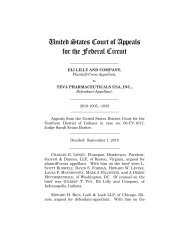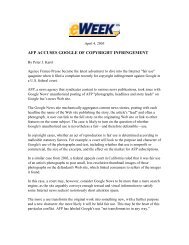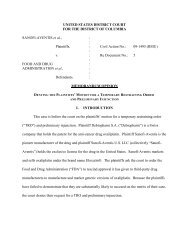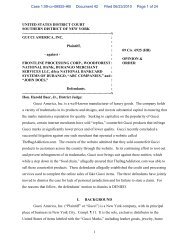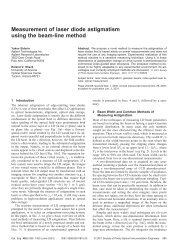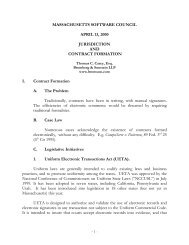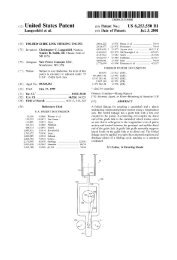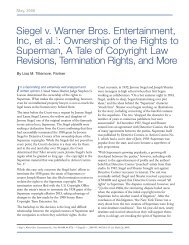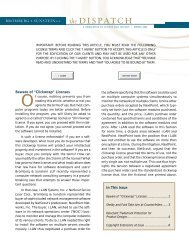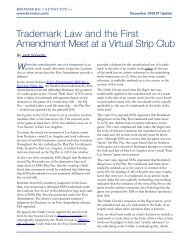- Page 3: THE EVOLVING IP MARKETPLACE:ALIGNIN
- Page 7 and 8: THE EVOLVING IP MARKETPLACE:ALIGNIN
- Page 9 and 10: innovation with significant benefit
- Page 11: calculating patent damages and reco
- Page 14 and 15: ecause they occur before the purcha
- Page 16 and 17: • Language is inherently imprecis
- Page 18 and 19: Improving the Ability to Understand
- Page 20 and 21: enables all participants in the pat
- Page 24 and 25: market reward for the invention, me
- Page 26 and 27: licensor and willing licensee would
- Page 28 and 29: easonable royalty damages. Recent c
- Page 30 and 31: Recommendation. Consistent with FRE
- Page 32 and 33: How Permanent Injunctions Affect In
- Page 34 and 35: Recommendation. Courts should consi
- Page 36 and 37: exclusion order, which is sometimes
- Page 38 and 39: CHAPTER 1EVOLVING PATHWAYS OF INNOV
- Page 40 and 41: II.THE INCREASING IMPORTANCE OF OPE
- Page 42 and 43: 18from a design house that develops
- Page 44 and 45: 29universities, leading to over 700
- Page 46 and 47: 41products of the collaboration wil
- Page 48 and 49: 54 55industries, and the IT sector
- Page 50 and 51: merit and promise, or as a defensiv
- Page 52 and 53: IV.AREAS OF PATENT POLICY THAT AFFE
- Page 54 and 55: alancing these concerns and recomme
- Page 56 and 57: I. INTRODUCTIONCHAPTER 2THE EVOLVIN
- Page 58 and 59: A. Beneficial EffectsThe ability of
- Page 60 and 61: Ex post patent transactions can als
- Page 62 and 63: industries where innovation is gene
- Page 64 and 65: can also encourage ex post transact
- Page 66 and 67: copied the patented technology, as
- Page 68 and 69: the patent marketplace are not avai
- Page 70 and 71: One panelist described his firm, Ac
- Page 72 and 73:
80to bring litigation. And at the e
- Page 74 and 75:
should respond. The effect of these
- Page 76 and 77:
technology from start-ups often pre
- Page 78 and 79:
transactions that harm innovation f
- Page 80 and 81:
I. INTRODUCTIONCHAPTER 3PATENT NOTI
- Page 82 and 83:
10Such uncertainty can greatly inhi
- Page 84 and 85:
and telecommunications, patent noti
- Page 86 and 87:
35not to acquire and commercialize
- Page 88 and 89:
47Most of it, however, addressed th
- Page 90 and 91:
63“‘through,’ . . . ‘to’,
- Page 92 and 93:
Institutional concerns/deferred res
- Page 94 and 95:
95been made. Third parties can trac
- Page 96 and 97:
C. Difficulties in Sifting Through
- Page 98 and 99:
pharmaceuticals, there is a very lo
- Page 100 and 101:
A. Improving the Ability to Underst
- Page 102 and 103:
Several of the panelists suggested
- Page 104 and 105:
- the applicant had not disclosed s
- Page 106 and 107:
indefiniteness invalidates the pate
- Page 108 and 109:
circumstances in which a patent’s
- Page 110 and 111:
description requirement; the second
- Page 112 and 113:
205ambiguous. Enablement provides l
- Page 114 and 115:
216regarding applicable skill level
- Page 116 and 117:
225dictionary or accept the use of
- Page 118 and 119:
specific technology at hand. (2) De
- Page 120 and 121:
247clarity. With its just-issued Su
- Page 122 and 123:
258considered part of the prosecuti
- Page 124 and 125:
Noting the “benefits of publicati
- Page 126 and 127:
going to be difficult to have the p
- Page 128 and 129:
happens, enforcement of such claims
- Page 130 and 131:
prolonged continuation practice - c
- Page 132 and 133:
D. Improving the Ability to Sift Th
- Page 134 and 135:
314them in reverse chronological or
- Page 136 and 137:
equire such recordation, although a
- Page 138 and 139:
or the allocation of burdens for su
- Page 140 and 141:
354proposed broadening the existing
- Page 142 and 143:
136
- Page 144 and 145:
CHAPTER 4THE ECONOMIC AND LEGAL FOU
- Page 146 and 147:
Consumers benefit from the competit
- Page 148 and 149:
Patent damage awards should reflect
- Page 150 and 151:
The threat of an injunction also cr
- Page 152 and 153:
29innovation. When infringers are a
- Page 154 and 155:
IV.CONCLUSIONPatent damages that ei
- Page 156 and 157:
CHAPTER 5LOST PROFITS DAMAGESI. INT
- Page 158 and 159:
assumed that the remainder of the i
- Page 160 and 161:
prices for it. In the world without
- Page 162 and 163:
ule makes the determination of dama
- Page 164 and 165:
patentees. Patentees that have prov
- Page 166 and 167:
CHAPTER 6THE HYPOTHETICAL NEGOTIATI
- Page 168 and 169:
7of patent disputes. (Appendix A re
- Page 170 and 171:
Panelists opposed to changes in dam
- Page 172 and 173:
Courts invoke the hypothetical nego
- Page 174 and 175:
37want to license the patent at the
- Page 176 and 177:
not justify inflating the reasonabl
- Page 178 and 179:
Concerns about compensating unprove
- Page 180 and 181:
67 68non-infringers might have paid
- Page 182 and 183:
determining the bargain the parties
- Page 184 and 185:
V. CHOOSING THE ROYALTY BASE.......
- Page 186 and 187:
3. The nature and scope of the lice
- Page 188 and 189:
8as an important benefit. The condi
- Page 190 and 191:
22exhaustive list of categories of
- Page 192 and 193:
30was excessive. When substitute te
- Page 194 and 195:
43wings.’” Some district courts
- Page 196 and 197:
53products. As these switching cost
- Page 198 and 199:
Before the standard is chosen, tech
- Page 200 and 201:
Clarification of reasonable royalty
- Page 202 and 203:
court may conclude that “there is
- Page 204 and 205:
93$200 million. Microsoft challenge
- Page 206 and 207:
ules of thumb or benchmarks, instea
- Page 208 and 209:
patents or portfolios that cover wh
- Page 210 and 211:
As recently as 2010, the Federal Ci
- Page 212 and 213:
The recent district court decision,
- Page 214 and 215:
entire market value of the product
- Page 216 and 217:
presents a practical problem for ac
- Page 218 and 219:
Recommendation. Courts should ident
- Page 220 and 221:
VII. REMEDIES IN THE INTERNATIONAL
- Page 222 and 223:
II.CASE LAW ANALYZING PERMANENT INJ
- Page 224 and 225:
suggests that the patent owner is o
- Page 226 and 227:
B. Firms that Primarily License Out
- Page 228 and 229:
31license technology that is essent
- Page 230 and 231:
aise costs and deter innovation. Th
- Page 232 and 233:
51from the non-infringing ones” a
- Page 234 and 235:
exclusive control over an invention
- Page 236 and 237:
This is not to say, however, that c
- Page 238 and 239:
771986 Federal Circuit case that pr
- Page 240 and 241:
87decisions, comparing the benefits
- Page 242 and 243:
which is licensed . . . By contrast
- Page 244 and 245:
106leverage in post-verdict licensi
- Page 246 and 247:
(exclusion orders) and district cou
- Page 248 and 249:
The FTC suggests that the ITC consi
- Page 250 and 251:
VIII.CONCLUSIONThe eBay injunction
- Page 252 and 253:
6Chart 1Patent holder median damage
- Page 254 and 255:
The PricewaterhouseCoopers study fu
- Page 256 and 257:
Chart 5 20C OIYIPO' ition of darnag
- Page 258 and 259:
29adjusted for decisions on post tr
- Page 260 and 261:
not practice its inventions, had li
- Page 262 and 263:
eBay decision in May 2006. Since th
- Page 264 and 265:
28thus the opinion must have discus
- Page 266 and 267:
III.Analysis of the Four Factors in
- Page 268 and 269:
“sticky” customers has been one
- Page 270 and 271:
50compensated by money damages wher
- Page 272 and 273:
63 64Voda and Telcordia , the paten
- Page 274 and 275:
that the patentee would suffer in t
- Page 276 and 277:
In some cases, courts have found th
- Page 278 and 279:
102patent rights. In z4, defendant
- Page 280 and 281:
Sundance Inc. v. DeMonte Fabricatin
- Page 282 and 283:
I-Flow Corp. v. Apex Medical Techno
- Page 284 and 285:
Wald v. Mudhopper Oilfield Servs.,
- Page 286 and 287:
APPENDIX CHEARING PARTICIPANTSParti
- Page 288 and 289:
ParticipantPeter N. DetkinFounder &
- Page 290 and 291:
ParticipantJoe E. KianiChief Execut
- Page 292 and 293:
ParticipantJohn T. McNelisPartner a
- Page 294 and 295:
ParticipantThe Honorable Sue L. Rob
- Page 296 and 297:
ParticipantTracey R. ThomasChief IP
- Page 298 and 299:
Alice A. KipelPartner, Steptoe & Jo
- Page 300 and 301:
NameComment DateJones, Nathan Novem
- Page 302 and 303:
Panelist Presentations at the Heari
- Page 304 and 305:
APPENDIX EANNOUNCED AGENDA TOPICS F
- Page 306 and 307:
INDUSTRY ROUNDTABLES(March 18, 2009
- Page 308:
THE NOTICE FUNCTION OF PATENTS AND



